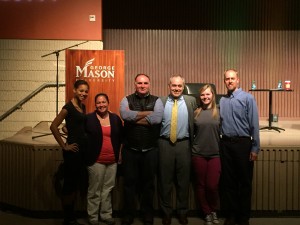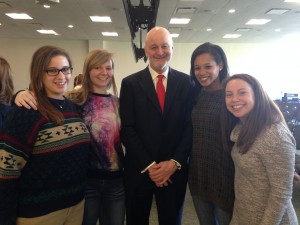Coming to George Mason University was the first step in my journey to becoming a better communicator. I quickly realized that one needs to communicate in order to prosper in life. Joining the LEAD team was the second step in this process. As a Leadership Consultant, it is a must to communicate with others to effectively achieve the goals I set out in front of me.

Professional chef, Jose Andres, and President Cabrera at the Fall 2015 Freedom and Learning Forum.
By facilitating multiple workshops, I have grown to endure many different situations involving how to properly communicate with others. The most important aspect of this is knowing who your audience is. Once I know who or what group I will be facilitating, I advise a plan catered to that group. As an example, I worked with Jewish Community Center students who are also a part of the Mason Life program. My team and I decided to guide a conversation about what objects were the most important to survival when stranded on a lifeboat.
This experience was the most influential during my time working in the LEAD Office. I had always been afraid of facilitating with diverse audiences due to the fact that I felt I could not empathize with them. However, after pushing myself to do the best I could, I learned that I am more capable than I thought. I was able to empathize with the students, engage in active listening, and create and share meaning with them.
Also, I have learned how to communicate properly with professionals both through email and in person. Through my involvement with LEAD, I have met the president of George Mason University, a professional and well-known chef, the ambassador of Spain, as well as many other important faculty members. These interactions have shed knowledge on my understanding of how to interact with professionals and how to be a professional myself. It is important to treat others with respect, but to also remember that they are humans. In most of my emails that I send out to faculty, I attempt to not sound like a robot while also maintaining a proficient and acceptable message.

Ambassador of Spain, Ramón Gil-Casares, and the LEAD team at the Spring 2016 Freedom and Learning Forum.
During face-to-face exchanges, I try to practice being calm and being myself. Whenever I try to be someone I am not, I clam up and the conversation goes downhill very quickly. By having humility and integrity, I am able to be myself, which makes it much easier to communicate effectively and connect with whoever I am talking to. This applies to communicating with peers, faculty, and anyone else I come into contact with.
Without being able to create meaning through conversing with others and engaging in active listening, I would not be able to be where I am today. Learning how to communicate with diverse audiences has been my biggest step during my time as a Leadership Consultant. All of these major components to communication are now very evident in my skills. I continue to grow as a communicator in everything that I do in order to be the best that I can be as a leader.
